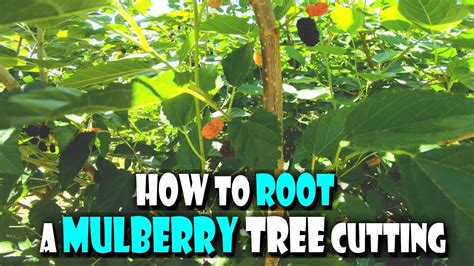How To Root Mulberry Cuttings
Ronan Farrow
Apr 02, 2025 · 3 min read

Table of Contents
How to Root Mulberry Cuttings: A Step-by-Step Guide for Successful Propagation
Mulberries are beautiful, versatile trees known for their delicious fruit and attractive foliage. Propagating mulberries from cuttings is a rewarding and cost-effective way to expand your garden or share these delightful trees with others. This guide provides a comprehensive, step-by-step approach to successfully rooting mulberry cuttings. We'll cover everything from selecting the right cuttings to providing optimal care for healthy root development.
Choosing the Perfect Cuttings
The success of rooting mulberry cuttings heavily depends on selecting the right material. Here's what to look for:
- Timing is Key: The best time to take cuttings is during the dormant season (late fall to early spring) or immediately after the new growth flushes in late spring/early summer. Dormant cuttings are generally preferred for higher success rates.
- Healthy Wood: Select cuttings from healthy, disease-free branches of the current year's growth (semi-hardwood cuttings) or from the previous year’s growth (hardwood cuttings). Avoid cuttings from diseased or damaged branches.
- Cut Length & Diameter: Aim for cuttings that are 6-8 inches long and about the thickness of a pencil.
- Nodes & Buds: Ensure your cuttings have at least two or three nodes (points where leaves or branches grow from the stem). These nodes are crucial for root development.
Preparing Your Cuttings for Rooting
Proper preparation significantly increases the chances of successful rooting. Follow these steps:
- Sharp Cut: Use a clean, sharp knife or pruning shears to make clean cuts at a 45-degree angle at the bottom of each cutting. This improves water absorption.
- Remove Lower Leaves: Remove the lower leaves from the cutting to prevent rotting. Leave a few leaves at the top to aid in photosynthesis.
- Wound Treatment (Optional): You can optionally dip the cut ends in rooting hormone powder. This isn't strictly necessary, but it can help stimulate root development.
Rooting Methods: Your Choices
There are several methods to root mulberry cuttings. Here are two popular techniques:
1. Using a Rooting Medium:
- Choose Your Medium: Use a well-draining potting mix, or a mixture of perlite and vermiculite.
- Planting the Cuttings: Plant your prepared cuttings about 2 inches deep, ensuring the nodes are buried in the rooting medium.
- Moisture & Humidity: Maintain consistently moist (but not soggy) soil and high humidity. You can achieve this by covering the container with a plastic bag or humidity dome.
- Indirect Light: Place the cuttings in a location with bright, indirect light. Direct sunlight can scorch the leaves.
2. Water Propagation:
- Clean Water: Place the cuttings in a jar or container filled with clean, fresh water. Change the water every 2-3 days to prevent bacterial growth.
- Light & Temperature: Keep the cuttings in a location with bright, indirect light and a warm temperature.
- Root Development: You should start to see roots developing within a few weeks. Once roots have grown to about an inch, they are ready to be planted in soil.
Aftercare and Transplanting
Once your cuttings have developed a robust root system (usually after several weeks or months), it's time to transplant them.
- Gradually Acclimate: Gradually acclimate the rooted cuttings to outdoor conditions over a week or two before transplanting them into their permanent location. This reduces transplant shock.
- Soil Preparation: Prepare the planting site by loosening the soil and amending it with organic matter.
- Spacing: Ensure adequate spacing between plants.
- Watering: Water regularly, especially during dry periods, to establish a strong root system.
Troubleshooting
- Wilting: If the cuttings wilt, it means they are not receiving enough water. Increase watering frequency and humidity.
- Rotting: If cuttings rot, it likely means the soil is too wet. Improve drainage and reduce watering.
- No Root Growth: Lack of root growth might indicate insufficient humidity or improper cutting preparation. Ensure proper humidity and use rooting hormone if needed.
By following these detailed instructions, you should significantly increase your chances of successfully rooting mulberry cuttings. Remember, patience and consistent care are vital for achieving successful propagation. Happy gardening!
Featured Posts
Also read the following articles
| Article Title | Date |
|---|---|
| How To Take Care Of A Frosty Fern | Apr 02, 2025 |
| How To Start Up A Salt Water Pool | Apr 02, 2025 |
| How To Secure A Generator From Theft | Apr 02, 2025 |
| How To Style Sheepskin Rug | Apr 02, 2025 |
| How To Set Up A Rotary Tattoo Machine | Apr 02, 2025 |
Latest Posts
-
Lethal Company How To Respawn
Apr 03, 2025
-
King Of Pentacles How Someone Feels About You
Apr 03, 2025
-
Judgement How Someone Feels About You
Apr 03, 2025
-
Jack Howe Memorial Tournament
Apr 03, 2025
-
Invisalign Refinements How Many
Apr 03, 2025
Thank you for visiting our website which covers about How To Root Mulberry Cuttings . We hope the information provided has been useful to you. Feel free to contact us if you have any questions or need further assistance. See you next time and don't miss to bookmark.
